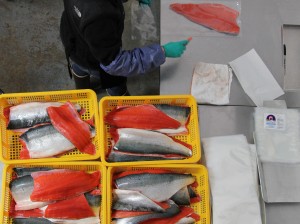
According to the McDowell group, this past summer’s sockeye is selling a little faster than it did in 2014.
The McDowell Group published its fall market outlook for the Bristol Bay Regional Seafood Development Association this week. Fisheries Analyst Andy Wink said so far fish is moving faster than it did last year.
“The frozen h&g product has actually been moving out pretty quickly, you know, being sold through the wholesale market,” he said. “We’re also seeing good sales volumes at the retail side for fillets. That’s really encouraging because more than anything, the industry and the fishery needs this increase in harvest and production to get through the supply chain as fast as possible before we get to next season.”
Wink said the inventory of canned salmon has decreased, as have canned salmon prices, but change comes more slowly in that sector.
“The inventory there is a little bit more problematic. Canned sales tend not to react as quickly to changes in price or production,” Wink said. “There’s a USDA buy, that’s going to help, but it’s going to take some time to unwind. … It’s kind of a more limited set of consumers, and how much more volume can you push into that consumer base.”
The report also looked at one of the big questions making the rounds in fishing communities and on social media: are fishermen getting their fair share of the sockeye’s value? A table on page three shows that so far, fishermen’s take-home pay from this summer was a smaller percentage of the first wholesale value than in ears past.
“To provide some data on that, we took all the wholesale sales and divided that by the volume of that product, and that’s where we came up with an average first wholesale value per processed pound,” he said. “So we compared those average value per pound to the exvessel price. What the table and the data tell us, is it that it was pretty consistent kinda within a range from 2006 to 2013. Then in 2014, fishermen tended to get more of the value and in 2015 they got a much lower percentage of it.”
Wink cautioned that for 2015, the table only compares the base ex-vessel price to the first wholesale value. The other comparisons can’t come until there’s more information. Bonuses still to come and not-yet-sold inventory will eventually play into the final picture of 2015.
The report looked at other factors influencing the world sockeye market – like the Russian embargo that’s resulted in more farmed Norwegian fish in other markets; a general trend of lower prices for all types of salmon; and even the lower price for smaller fillets, which increased sales in Japan this summer but meant less revenue from other sales.
The report also included data from retail sales – purchases of filets and canned fish increased this year, a positive sign. As for the 2016 outlook? Wink says he’ll be watching to see what prices are this winter, and how much more fish sells before the 2016 run returns.




